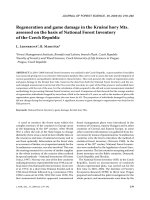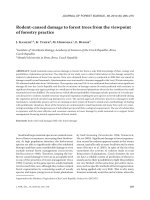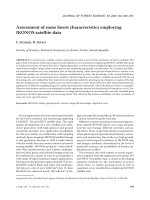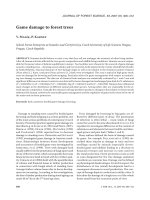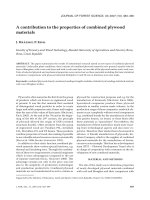Báo cáo lâm nghiệp: " Game damage to forest trees" ppsx
Bạn đang xem bản rút gọn của tài liệu. Xem và tải ngay bản đầy đủ của tài liệu tại đây (270.89 KB, 7 trang )
406 J. FOR. SCI., 53, 2007 (9): 406–412
JOURNAL OF FOREST SCIENCE, 53, 2007 (9): 406–412
Damage to standing trees caused by hoofed game
browsing and bark stripping is a serious problem, one
of the most serious problems of contemporary Czech
forestry. Protection practices against game damage are
described e.g. in Š et al. (1981) and P (1997).
H (1995), H (1995), M (1995)
and P (1995) reported how to decrease
damage to standing trees. R and S
(1992) investigated game damage in Austrian condi-
tions. Relationships between forest development
and occurrence of hoofed game were investigated by
J et al. (1999). Trees with damaged bark
usually suffer from the penetration of fungi spores and
decay of diverse extent, which consequently decreases
financial income hand in hand with low timber qual-
ity. Č et al. (2004) dealt with the quantification
of volume and financial losses in timber production
in connection with fungal attack of standing trees.
Average timber volume losses due to decay develop-
ment are increasing. According to his investigations,
the loss of timber production during stand ageing can
reach 48 m
3
/ha in the 5
th
stand age class.
Trees damaged by browsing by big game are af-
flicted by different types of decay. e penetration
of infection is often lethal – many kinds of fungi
cause the wood to become discoloured or to rot. It is
expedient to investigate differences in the content of
substances and elements between healthy and dam-
aged spruce and pine bark (Tables 1 and 2).
Many authors defined the basis of damage caused
by game. For example P (1995) de-
scribed these injuries as damage to trees and tree
seedlings caused by animals (especially cloven-
hoofed game and rabbits) leading to a decrease in
financial revenues and increase in costs used for
the stand protection. Forest protection costs as well
as costs designated for the tree damage sanitation
constitute an economic loss. Damage can be defined
as physiological disadvantages. From this aspect, the
disturbances of tree (stand) development lead to a
consequent decrease in wood production. e con-
cept of damage depicts a reduction in utility value. It
describes the damage of a single tree or of the whole
forest stand from the economic point of view.
Game damage to forest trees
V. M, P. K
School Forest Enterprise at Kostelec nad Černými lesy, Czech University of Life Sciences Prague,
Prague, Czech Republic
ABSTRACT: Humans should behave in such a way that they will not endanger the existence of other living entities.
After all, human activities affected the tree species composition and wildlife living conditions. Humans are now respon-
sible for the preservation of delicate equilibrium in nature. Two localities were chosen for the research of game damage
caused to standing trees – shooting areas Lužánky and Červený jelen, both situated in the vicinity of Jindřichův Hradec
in South Bohemia. Seasonal character of tree-damage origin as well as its relation to the chemical content of spruce
(Picea abies [L.] Karst.) and pine (Pinus sylvestris [L.]) bark were investigated. is area is typical of high game stock;
trees are damaged by browsing and bark stripping. Particular advice for game management with respect to minimiz-
ing tree damage is presented. e data set of chemical bark analyses was statistically evaluated by t- and F-test and
significant differences in element contents were detected between damaged and undamaged pine bark for N-substances
(P = 0.003309), Ca (P = 0.001460), P (P = 0.004343), Mg (P = 0.001419) and K (P = 0.016290). Humans have influenced
many changes in the distribution of different animal and plant species. Among others they are responsible for the al-
tered species composition. Typically the extinction of large predators produces changes in food chains. In forest stands
influenced by human activities the reasonable game management and the regulation of game stock seems to be one of
the main tools in forest protection.
Keywords: bark; nutrients; hoofed game damage; browsing
J. FOR. SCI., 53, 2007 (9): 406–412 407
Originators of damage have to be identified in
order to prevent tree damage. In practice it is not
as easy as it appears at first sight. Determination
of the actual wildlife species that causes damage to
forest trees has to be carried out according to marks
on damaged trees, such as incisor width, height of
the lower boundary of nibbled or excoriated bark
of trees. Other clues that can be used for the deter-
mination of damage originators are marks such as
trails, lairs and droppings. Determination of brows-
ing originators becomes more difficult with elapsed
time. e exact time of browsing occurrence is also
vital for the determination of hoofed game species
causing the damage. e unevenly circular surface
area of removed bark is typical of browsing by the
cloven-hoofed game, the boundaries of the damaged
place are flaggy with tattered and partially plucked
phloem. Red deer prefer thinner trunks for bark
stripping (V et al. 2006).
A modified tree species composition evocated
the impoverishment of food sources for hoofed
game during the last centuries of intensive land
use. Hoofed game reoriented themselves to forest
tree species – in fact a valuable source of important
nutrients and chemical substances. Game managers
and foresters should consider the options whether
they are able to prevent great damage to forest
stands caused by big game. is question becomes
crucial in the conditions of vast pine and spruce
monocultures.
In Central Europe hoofed game feeding in hard
times has a long-term tradition; it is recommended
even in older hunting literature. In relation to for-
est protection, the danger of increasing browsing is
highlighted as far as hoofed game feeding is not car-
ried out correctly (V 1997). Since avail-
ability and nutritional quality are seasonally variable,
the importance of alternative food resources changes
between seasons (M at al. 2006). In recent years
distinct opinions appeared which impugned the ne-
cessity and expediency of winter hoofed game feed-
ing (K, K 1991; H 1997, etc.).
MATERIAL AND METHODS
Two localities were chosen for the purposes of
observation and evaluation of tree damage caused by
hoofed game – shooting area Lužánky and shooting
ground Červený jelen.
Shooting ground Lužánky is situated in the south-
ern part of the Bohemian and Moravian Upland. Ave-
rage annual temperature is 6°C, the area is situated at
an elevation of 600–730 m above sea level. e main
part of the shooting ground belongs to the 6
th
vegeta-
Table 1. Changes in the content of substances and elements between intact and hoofed game-damaged pine bark (g/kg)
Scotch pine
mean values
N-subst. Lipids Ash matter Pulp
Nitrogen-free
substances
Sugars Ca P Mg K Na Co
Intact bark 35.72 59.05 38.25 209.15 655.43 146.57 5.19 0.64 0.68 2.47 0.08 0.07
Damaged bark 46.86 52.51 34.45 221.70 644.15 156.42 3.64 0.81 0.88 3.10 0.11 0.05
Table 2. Changes in the content of substances and elements between intact and hoofed game-damaged spruce bark (g/kg)
Norway spruce
mean values
N-subst. Lipids Ash matter Pulp
Nitrogen-free
substances
Sugars Ca P Mg K Na Co
Intact bark 34.35 47.01 43.14 246.99 630.69 140.85 9.07 0.60 0.72 2.82 0.09 0.10
Damaged bark 31.40 50.75 47.80 217.80 652.15 142.44 7.34 0.65 0.66 3.19 0.09 0.09
408 J. FOR. SCI., 53, 2007 (9): 406–412
tion gradient Piceeto-Fagetum. Norway spruce (Picea
abies [L.] Karst.) is the prevailing tree species cover-
ing 75% of the area, European beech (Fagus sylvatica
[L.]) is a major broadleaved tree species growing on
2% of the area. Red deer, mouflon, roe deer and wild
boar are present there all the year round.
Shooting area Červený jelen is situated at an eleva-
tion of 420–460 m above sea level. Average annual
temperature is 7.8°C. Scotch pine (Pinus sylvestris
[L].) covers 70% of the investigated area, Norway
spruce 20%, oak with 3% is the main broadleaved
tree species.
For the selection of appropriate forest stands the
criteria such as tree species representation, stand age,
current and former hoofed game damage and stand size
(> 0.5 ha) were used. Continuous occurrence of hoofed
game was also an important aspect. Four forest stands
were chosen for the respective experiment in this way.
In order to get bark from the same patch on the stem
where the browsing and/or bark stripping usually take
place, samples were taken at a height of 1.4–1.6 m.
Moreover, contents of micronutrients can differ in
various parts of the tree stem (H-T, S-
2005). Samples (up to 300 g each) were peeled off
from trees with intact bark and for a comparison also
from trees that were already browsed by hoofed game.
All damaged trees were marked in a given month so as
to avoid repetitive sample taking.
e following substances and macro- and micro-
elements were investigated: nitrogen substances,
lipids, ash matter, pulp, nitrogen-free substances,
sugars, calcium, phosphorus, magnesium, potas-
sium, sodium and cobalt.
RESULTS AND DISCUSSION
We performed chemical analyses of the bark of
damaged and undamaged trees and we analyzed the
changes in the content of nutrients and elements
during the whole year. Damaged pine forest stands
are richer in some substances and elements than
healthy forest stands, e.g. the content of nitrogen sub-
stances is higher in damaged pine bark by 11.14 g/kg,
pulp is higher by 12.55 g/kg, sugars are higher by
9.85 g/kg, phosphorus is higher by 0.17 g/kg, mag-
nesium by 0.20 g/kg, potassium by 0.63 g/kg, sodium
Fig. 1. Content of nitrogen substances
in spruce and pine bark in the course of
2-year investigation
Fig. 2. Content of Ca in pine and spruce
bark in the course of 2-year investiga-
tion
2.8
4.8
6.8
8.8
10.8
12.8
14.8
March
May
July
September
November
January
March
May
July
September
November
January
Month
(g/kg)
Spruce Pine
2.8
4.8
6.8
8.8
10.8
12.8
14.8
March
May
July
September
November
January
March
May
July
September
November
January
Month
(g/kg)
Spruce Pine
15
20
25
30
35
40
45
50
55
March
May
July
September
November
January
March
May
July
September
November
January
Month
(g/kg)
Spruce Pine
15
20
25
30
35
40
45
50
55
March
May
July
September
November
January
March
May
July
September
November
January
Month
(g/kg)
Spruce Pine
J. FOR. SCI., 53, 2007 (9): 406–412 409
by 0.03 g/kg. Opposite development was
detected in the following substances and
elements: the content of lipids is lower in
damaged pine forest stands by 6.54 g/kg, ash
matter is lower by 3.8 g/kg, nitrogen-free sub-
stances by 11.28 g/kg, calcium by 1.55 g/kg,
cobalt by 0.02 g/kg.
ese elements and substances have high-
er volumes in damaged spruce bark: lipids
by 3.74 g/kg, ash matter by 4.66 g/kg, nitro-
gen-free substances by 21.46 g/kg, sugars by
1.59 g/kg, phosphorus by 0.05 g/kg, potas-
sium by 0.37 g/kg. Opposite development in
the volume of elements and substances: the
content of pulp is lower in damaged forest
stands by 29.19 g/kg, nitrogen substances by
2.95 g/kg, calcium by 1.73 g/kg, magnesium
by 0.06 g/kg, cobalt by 0.01 mg/kg.
Bark samples were taken in a 2-year pe-
riod and changes in the content of elements
and substances are shown in Figs. 1 to 5.
The t-test confirmed statistically sig-
nificant differences in element content
between damaged and undamaged pine
bark. Significant differences were detected
for N substances (P = 0.003309), calcium
(P = 0.001460), phosphorus (P = 0.004343),
magnesium (P = 0.001419) and potassium
(P = 0.016290). Comprehensive values are
shown in Table 3.
Nitrogen substances (proteins and an-
other substances) form a major part of body
organs, tissues, enzymes, hormones, pig-
ments in animal bodies. ey are inevitable
for muscular progression and embryonic
development. ey cannot be substituted
by any other nutrients.
Calcium is necessary for muscular contrac-
tion, appropriate utilization of proteins and
together with phosphorus they are important
for the mineralization of bones and teeth.
Phosphorus is essential for skeleton progres-
sion and metabolism as well as for muscular
activity. The correct Ca:P ratio plays an
important role in phosphorus utilization. A
higher proportion of P is required by females
at the time of pregnancy. Potassium is neces-
sary for the appropriate metabolism of sugars
and proteins as well as for the function of
some enzymes. Magnesium is vital for bone
formation, decreases blood coagulation and
prevents development of thrombosis.
Based on research findings and present
knowledge, the following principles and
Table 3. Statistical analyses of pine bark (mean 1 damaged, mean 0 undamaged bark)
Mean
t-value df P
Valid N Std. dev.
F-ratio P
1 0 1 0 1 0
N-subst. 46.8625 35.7167 3.19162 30 0.003309 8 24 8.87673 8.45354 1.102627 0.788695
Lipids 52.5125 59.0458 –1.13736 30 0.264390 8 24 16.57110 13.21596 1.572189 0.387408
Ash matter 34.4500 38.2542 –0.38649 30 0.701864 8 24 21.79692 24.77137 1.291546 0.770361
Pulp 221.7000 209.1542 1.34856 30 0.187572 8 24 16.98478 24.28039 2.043579 0.335054
N-free s. 644.1500 655.4333 –0.92467 30 0.362516 8 24 19.63539 32.37256 2.718159 0.176771
Ca 3.6438 5.1913 –3.50437 30 0.001460 8 24 0.42765 1.21262 8.040325 0.008647
P 0.8113 0.6442 3.08536 30 0.004343 8 24 0.09658 0.14182 2.156404 0.298972
Mg 0.8813 0.6750 3.51515 30 0.001419 8 24 0.09963 0.15467 2.409817 0.233910
K 3.0975 2.4696 2.54551 30 0.016290 8 24 0.47737 0.63785 1.785409 0.439740
Na 0.1075 0.0767 1.56261 30 0.128634 8 24 0.08207 0.03158 6.755295 0.000414
NO
3
0.1725 0.1787 –0.33565 30 0.739474 8 24 0.03412 0.04857 2.026340 0.341026
Co 48.8175 65.0288 –0.71386 30 0.480832 8 24 37.66812 60.03478 2.540142 0.207300
Sugars 156.4206 146.5715 0.80988 30 0.424387 8 24 40.82732 25.49770 2.563891 0.083064
Temp. 2.9625 7.4958 –1.61743 30 0.116254 8 24 6.38188 7.00599 1.205152 0.853153
Precipitation 47.7125 64.2750 –0.96845 30 0.340565 8 24 19.25256 46.64963 5.871097 0.022301
410 J. FOR. SCI., 53, 2007 (9): 406–412
regulations can be recommended for the reduction
in tree damage caused by hoofed game. An elemen-
tary condition is the reduction in the number of
cloven-hoofed game to such a stock that will enable
new forests to be naturally established. It is not only
in the interest of forests and game animals but also of
all humans (Z 1995). It is also expedient to
improve the carrying capacity of the hunting ground,
i.e. to recover crop fields, to plant fructiferous
broadleaved trees on the boundary of grazing areas.
e location of feed racks is not advisable either in
young forest stands or in their neighbourhood. On
the contrary, feed racks should be placed in mature
forest stands. Pine bark can be used as feedstuff;
felled trees can be left on the ground for hoofed
game browsing. e felling should be carried out in
older stands which are not situated in the proximity
of young stands and non-established plantations. It
is expedient to carry out juvenile thinning in young
pine forest stands only in spring and summer. When
this operation takes place in autumn or winter,
hoofed game are attracted by freshly cut timber,
animals concentrate in these stands, they primarily
nibble felled trunks and when there is nothing left,
they continue browsing on other standing trees. No
such negative browsing occurs in forests where juve-
nile thinning is carried out in spring or summer. is
way of felling timing enables quick bark withering
and the timber is not attractive for hoofed game any
more – standing trees growing close to felled ones
are not subsequently damaged. Shooting should be
carried out continuously during the hunting season.
Increased shooting at the end of the year makes the
hoofed game stressed. For this reason game animals
spend a lot of time in young forests where they cause
damage to standing trees. Forestry and game man-
agement must not be contradictory. e solution of
this situation consists in the achievement of ecologi-
cally adequate hoofed game stock. Nowadays, game
management has to be primarily considered as an
activity aimed at the preservation of equilibrium in
the nature – animal protection associated with the
protection of forest environment.
The most notable facts standing against the
background of great damage to forest trees are as
follows:
Fig. 3. Content of P in pine and spruce
bark in the course of 2-year investiga-
tion
Fig. 4. Content of Mg in pine and spruce
bark in the course of 2-year investiga-
tion
0.32
0.42
0.52
0.62
0.72
0.82
0.92
March
May
July
September
November
January
March
May
July
September
November
January
Month
g/kg
S
p
ruce Pine
0.32
0.42
0.52
0.62
0.72
0.82
0.92
March
May
July
September
November
January
March
May
July
September
November
January
Month
g/kg
S
p
ruce Pine
0.3
0.4
0.5
0.6
0.7
0.8
0.9
1.0
March
May
July
September
November
January
March
May
July
September
November
January
Month
(g/kg)
S
p
ruce Pine
0.3
0.4
0.5
0.6
0.7
0.8
0.9
1.0
March
May
July
September
November
January
March
May
July
September
November
January
Month
(g/kg)
S
p
ruce Pine
(g/kg)
J. FOR. SCI., 53, 2007 (9): 406–412 411
– e high number of cloven-hoofed game is not in
accordance with standard stock. e number of
wildlife ruminants has to be equalized with food
sources in the area.
– Feed racks placed close to young forest stands
consequently increase damage to nearby forest
stands.
– Insufficient and low-class hoofed game feeding in
hard times. It is usually convenient to feed wildlife
game according to its needs.
– Game animals are substantially stressed and can
-
not fulfil regular pasture cycles because of the lack
of rest areas.
– Annual spruce and pine shoots as well as bark
are very rich in nutrients and elements; they
contain many nourishing elements and necessary
substances for animal nutrition, they serve as an
indispensable source of energy.
– With regard to the content of substances and ele
-
ments, spruce and pine bark is comparable to a
superior feedstuff.
– Game animals prevent alimentary troubles by the
intake of pulp whose artificial source is contained
in bark.
– Increasing power consumption and growing need
of timber during the last centuries led to changes
in forest structure from mixed all-aged forests to
conifer (mainly spruce) monocultures. In conse-
quence plant species diversity and food sources
for hoofed game decreased. Animals focused on
other food sources and started to damage forest
stands and farm crops.
– Natural animal species diversity and animal abun
-
dance were changed. Some wildlife species were
preferred; some animals were introduced (sika
deer, fallow deer, white-tailed deer, mouflon).
– Until the first half of the 19
th
century almost all large
predators were wiped out in Central Europe.
Refer ences
ČERMÁK P., GLOGAR J., JANKOVSKÝ L., 2004. Damage by
deer barking and browsing and subsequent rots in Norway
spruce stands of Forest Range Mořkov, Forest District
Frenštát p. R. (the Beskids Protected Landscape Area).
Journal of Forest Science, 50: 24–30.
HAGEN-THORN A., STJERNQUIST I., 2005. Micronutrient
levels in some temperate European tree species: compara-
tive field study. Trees, 19: 572–579.
HROMAS J., 1995. Myslivecké možnosti ovlivnění škod
zvěří na lese. In: Škody zvěří a jejich řešení. Brno, MZLU:
45–48.
HROMAS J., 1997. Péče o zvěř. In: VACH M. et al., Myslivost:
vývoj české myslivosti, zoologie, ekologie, chov a lov zvěře,
lovecká kynologie, myslivecké předpisy a lovecké střelectví.
Uhlířské Janovice, Silvestris: 256–263.
HUSÁK F., 1995. Škody zvěří z pohledu dnešní myslivosti. In:
Škody zvěří a jejich řešení. Brno, MZLU: 89–92.
JORRITSMA I.T.M., VAN HEES A.F.M., MOHREN G.M.J.,
1999. Forest development in relation to ungulate grazing:
a modelling approach. Forest Ecology and Management,
120: 23–34.
KOMÁREK V., KOČIŠ J., 1991. Biologické základy poľovnej
zveri. Bratislava, Príroda: 197.
MLČOUŠEK J., 1995. Příčiny škod zvěří na lese a možnosti je
ovlivňovat. In: Škody zvěří, jejich příčiny a prevence. Zlaté
Hory: 201–223.
MOSER B., SCHÜTZ M., HINDENLANG K.E., 2006. Impor-
tance of alternative food resources for browsing by roe deer
on deciduous trees: e role of food availability and species
quality. Forest Ecology and Management, 226: 248–255.
PLAŇANSKÝ K., 1995. Řešení škod zvěří z pohledu mys-
liveckého hospodáře. In: Škody zvěří a jejich řešení. Brno,
MZLU: 63–66.
POLLANSCHÜTZ J., 1995. Bewertung von Verbiss und Fe-
geschäden. Hilfsmittel und Materialen. Mitteilungen der
FBVA Wien, 169: 146.
Fig. 5. Content of K in pine and spruce
bark in the course of 2-year investiga-
tion
1.40
1.90
2.40
2.90
3.40
3.90
4.40
4.90
March
May
July
September
November
January
March
May
July
September
November
January
Month
(g/kg)
S
p
ruce Pine
1.40
1.90
2.40
2.90
3.40
3.90
4.40
4.90
March
May
July
September
November
January
March
May
July
September
November
January
Month
(g/kg)
S
p
ruce Pine
412 J. FOR. SCI., 53, 2007 (9): 406–412
PRIEN S., 1997. Wildschäden im Wald: Ökologische Grund
-
lagen und integrierte Schutzmaßnahmen. Berlin, Parey
Buchverlag: 257.
REIMOSER F., SUCHANT R., 1992. Systematische Kontroll-
zäune zur Feststellung des Wildeinflußes auf die Waldve-
getation. Allgemeine Forst- und Jagdzeitung, 163: 27–31.
ŠVARC J. et al., 1981. Ochrana proti škodám působeným
zvěří. Praha, SZN: 146.
VODŇANSKÝ M., 1997. Zimní krmení jelení a srnčí zvěře.
In: Nové možnosti hospodaření se zvěří. Mariánské Lázně:
23–26.
VODŇANSKÝ M., RAJSKÝ M., HELL P., SLAMEČKA J.,
2006. Einfluss der zeitbegrenzten Futteraufnahme auf
die Intensität der Sommerschäle des Rotwildes (Cervus
elaphus) in experimentellen Bedingungen. Beiträge zur
Jagd- und Wildforschung, 31: 159–165.
ZATLOUKAL V., 1995. Lesní hospodářství a myslivost. In:
Škody zvěří a jejich řešení. Brno, MZLU: 17–23.
Received for publication May 31, 2007
Accepted after corrections June 15, 2007
Škody zvěří na lesních dřevinách
ABSTRAKT: Člověk by se měl ve vztahu k přírodě chovat tak, aby neohrozil existenci jiných organismů. Bohužel
v důsledku lidské aktivity došlo ke změně druhové porostní skladby dřevin, pestrosti a výskytu rostlinných a živočiš-
ných druhů. Člověk má nyní odpovědnost za zachování křehké rovnováhy v přírodě. Pro výzkum škod působených
spárkatou zvěří na lesních porostech byly zvoleny dvě lokality v blízkosti Jindřichova Hradce – honitby Lužánky
a Červený jelen. Byl zkoumán sezonní charakter poškození a jeho vztah k chemickému složení borové (
Pinus sylvestris
[L.]) a smrkové (Picea abies [L.] Karst.) kůry. Zkoumaná oblast vykazuje vysoké počty spárkaté zvěře, stromy jsou
poškozovány ohryzem a loupáním kůry, případně okusem. Soubory dat z chemických analýz kůry u poškozených
a nepoškozených jedinců borovice a smrku byly zhodnoceny statisticky pomocí t- a F-testu. Statisticky průkazný
rozdíl v koncentracích mezi poškozenými a nepoškozenými stromy byl dosažen u dusíkatých látek (
P = 0,003309),
vápníku (P = 0,001460), fosforu (P = 0,004343), hořčíku (P = 0,001419) a draslíku (P = 0,016290) u borovice. Člověk
stojí v pozadí mnoha změn v přírodě, mimo jiné významným způsobem zasáhl do potravních řetězů vyhlazením
velké části predátorů z volné přírody. V silně antropicky ovlivněných lesních porostech se racionální hospodaření
se spárkatou zvěří a regulace jejích stavů stává jedním z hlavních nástrojů ochrany lesa.
Klíčová slova: kůra; živiny; škody spárkatou zvěří; ohryz
Corresponding author:
Ing. V M, Ph.D., Česká zemědělská univerzita v Praze, Školní lesní podnik v Kostelci nad Černými lesy,
náměstí Smiřických 1, 281 63 Kostelec nad Černými lesy, Česká republika
tel.: + 420 321 697 140, fax: + 420 321 697 458, e-mail:


